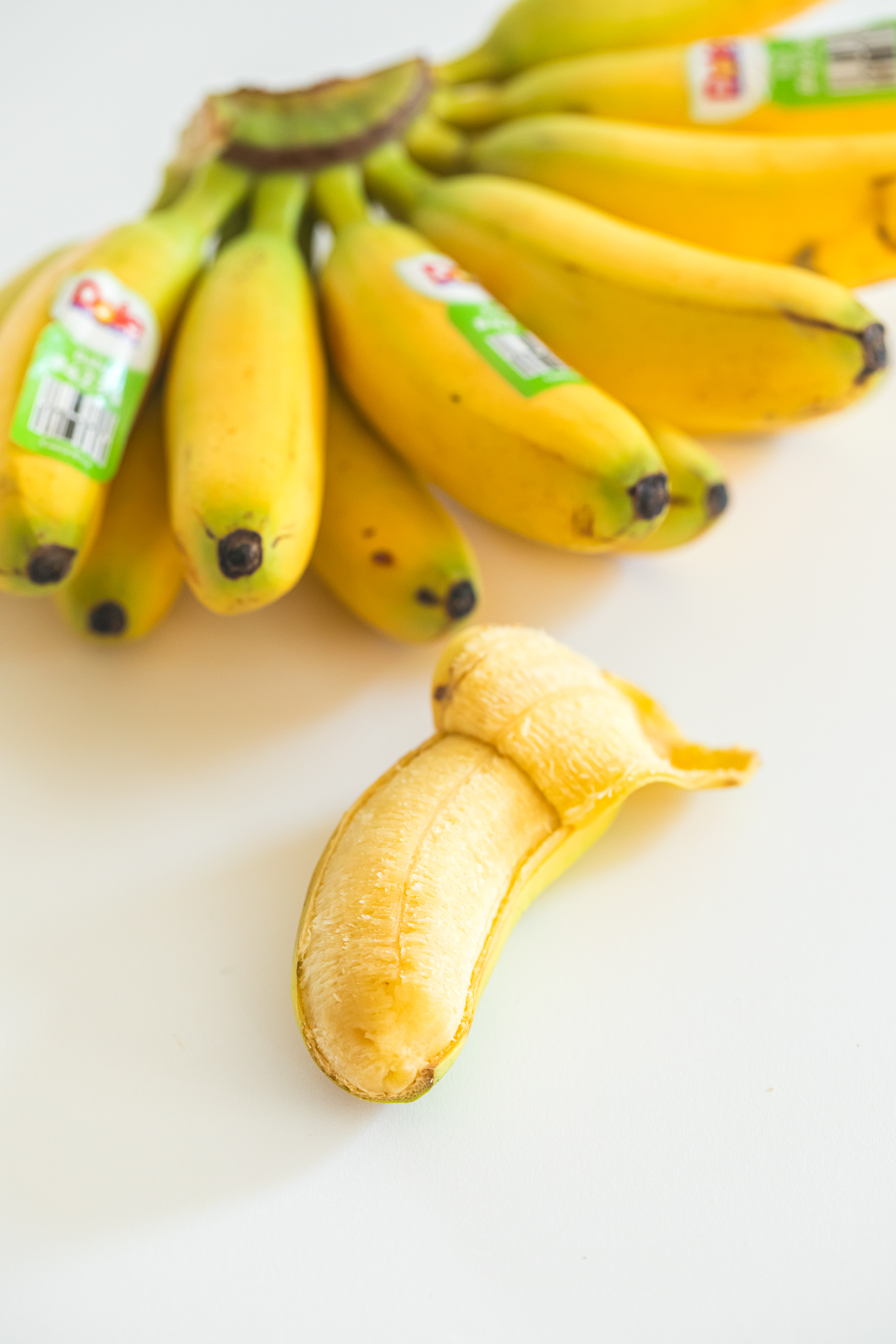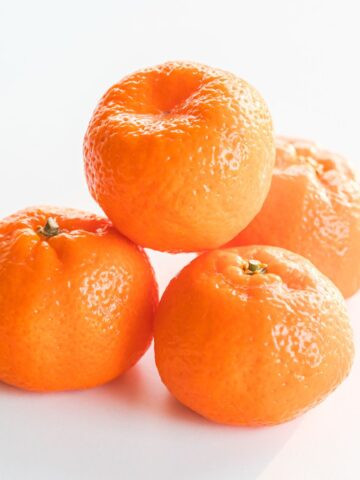All about Baby Bananas, from how to pick out baby bananas, how to eat baby bananas, how to store them and more.

What are baby bananas?
Baby bananas, also known as Lady Finger bananas, are a smaller variety of banana that are native to tropical regions of Southeast Asia. Unlike their larger counterparts, baby bananas are about 3 to 4 inches long, a bit sweeter, and a thinner peel. They are characterized by their sweet flavor and creamy texture, making them a favorite among banana enthusiasts.

What do baby bananas taste like?
Baby bananas taste sweeter and richer in flavor than the more common Cavendish bananas you’ll find regularly in supermarkets. They also have a more dense, creamy texture with hints of honey and apple. Their natural sweetness and small size make them a perfect, healthy snack.
What types of baby bananas are there?
The term “baby bananas” can refer to a few different varieties, including but not limited to:
- Lady Finger Bananas: These are the most common type of baby bananas. They’re known for their sweet taste, small size, delicate skin, and slender shape.
- Manzano Bananas: These bananas are also known as “Apple Bananas,” they are smaller with a sweet and tart apple-like flavor.
- Niño Bananas: Another small and sweet variety, similar in taste and size to Lady Fingers but can be slightly more aromatic.
- Pisang Mas (Musa acuminata ‘Pisang Mas’): Also known as “Golden Banana,” Pisang Mas baby bananas have a sweet and slightly tangy flavor. They are often used in desserts and snacks.
- Burro Banana (Musa acuminata ‘Burro’): These are short and chunky in size with a tangy, lemon-like flavor, ideal for cooking.
What’s the difference baby bananas and regular bananas?
The main differences between baby bananas and regular bananas (like the Cavendish) include size, taste, and texture. Baby bananas are smaller, sweeter, and have a creamier texture than larger bananas. They also have a thinner peel, taste much sweet when yellow without waiting for extensive browning, which is often preferred for regular bananas to reach peak sweetness for things like baking.

Baby bananas benefits
Baby bananas are not only delicious but also packed with nutrients. They are a good source of vitamins C, K E, A, B, phosphorous, iron, zinc, fiber, and potassium.
Consuming baby bananas may aid in digestion, promote heart health, and offer an energy boost without the crashes linked to processed sugars, thanks to their natural sugar content.
Baby bananas vs regular bananas nutrition content
Baby bananas pack a similar nutritional punch with some differences due to their size. Here’s a comparison of the nutritional content for both, based on an average serving size:
Baby Banana (approx. 81g or one small banana):
- Calories: 72
- Protein: 0.9 g
- Total Fat: 0.3 g
- Carbohydrates: 19 g
- Fiber: 2.1 g
- Sugars: 10.5 g
- Potassium: 290 mg
- Vitamin C: About 3 mg
Regular Banana (approx. 118g or one medium banana):
- Calories: 105
- Protein: 1.3 g
- Total Fat: 0.4 g
- Carbohydrates: 27 g
- Fiber: 3 g
- Sugars: 14 g
- Potassium: 422 mg
- Vitamin C: About 10 mg
While both types of bananas are a good source of potassium, vitamin C, dietary fiber, and simple sugars, a regular banana like a cavendish banana is larger and therefore contains more calories, carbohydrates, and nutrients overall.
Baby bananas are sweeter and a compact size. The exact nutritional content can vary based on the banana’s size and ripeness. We find baby bananas are great an excellent addition to smoothies especially when you want to cut some calories due to their rich banana flavor.
When are baby bananas in season?
Bananas are available year-round. They are harvested throughout the year in tropical regions.
How to Grow Baby Bananas
Growing baby bananas requires a warm, tropical or subtropical environment. They require rich, well-draining soil, plenty of sunlight, and adequate water. Plant them in a sheltered spot to protect them from strong winds.

How to pick out baby bananas
Go for baby bananas that are either green with a bit of yellow or nearly all yellow with a bit of green on the tops and bottoms. They should be firm to the touch. Avoid bananas with soft posts and bruises. That is unless you’ve found great deal and plan to freeze for smoothies!
Why are baby bananas more expensive
The short and sweet answer is that banana bananas aren’t in demand like regular bananas. They have smaller growing regions, smaller yields, and appeal to a niche market.

How to store baby bananas
Store baby bananas at room temperature until they ripen to your liking. Enjoy once ripe or freeze once ripened to use in smoothies or recipes.
How to freeze baby bananas
To freeze baby bananas, peel them first and cut them into slices if desired. Lay the slices on a baking sheet lined with parchment paper and freeze until solid. Then, transfer the frozen slices to a freezer-safe bag or container. Frozen baby bananas are perfect for smoothies, baking, or as a cold snack.

How to enjoy baby bananas
Baby bananas can be enjoyed raw, cooked, or baked. We love to eat them on their own as a snack or in cereal. They’re also delicious in banana bread, smoothies, or even healthy banana muffins! Their natural sweetness and creamy texture make them a versatile ingredient.

How to eat Baby Bananas
(click stars to vote)
Print Pin SaveIngredients
- 2 baby bananas
- produce wash
- water
Instructions
- Choose ripe baby bananas – Look for ones that are yellow with small brown spots and then wash the banana if needed.
- Gently peel the banana from the top down.
- Enjoy the baby banana whole or cut into bite-sized pieces for a quick, sweet treat.
Video
Nutrition
The nutritional information is automatically calculated and can vary based ingredients and products used. If the nutrition numbers are important for you we recommend calculating them yourself.










Leave a Reply